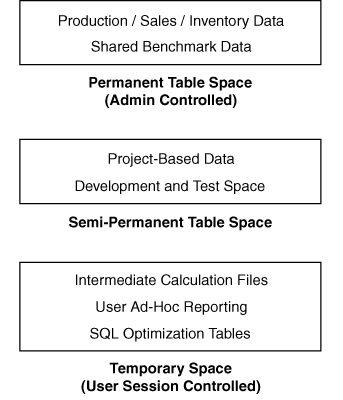Domains and Data Spaces
Overview of Domains and Data Spaces
You can configure SPD
Server to meet different data requirements. If you need different
types of SPD Server domain space, you can use domain declarations
in the libnames.parm file to configure spaces that balance processing
speed, space, and growth needs with data security requirements. Typically,
SPD Server users use most or all of the types of table spaces. The
type of queries and reports that the user makes can indicate the types
of data space that the user needs. The following figure shows the
three basic types of domain space.
Permanent Table Space
In SPD Server, large
production, inventory, and sales data storage areas work best using
permanent table space. A rolling 5-year sales data table organized
by division and company is an example of an SPD Server structure that
is best suited to permanently allocated space on the enterprise computers.
If you have this type of table, large quantities of production, inventory,
or sales data can be updated on a day-to-day, or even shift-to-shift,
basis. These data repositories require permanent, secure processing
space that can be accessed only by a select group of users. When
you allocate permanent space for the data, you ensure that disk space
that is required for combining and manipulating large amounts of data
from multiple large warehouse tables is always available.
For example, an organization
might call such a tightly controlled, permanently defined area the
production data space. Data analysts in organizations typically manipulate
production-type data to produce smaller, more focused reports. Analyst
reports often benchmark specific areas of performance or interest.
Regular analyst reports are frequently distributed across the organization.
The distributed analyst reports (although not as critical as the production,
inventory, or sales data) should also use permanently defined data
spaces that are separate from the permanent table spaces devoted to
production reporting. In this situation, permanent table space should
be accessible to a specific group (such as analysts) of regular SPD
Server users.
You can use the libnames.parm
file to configure paths that map to an area of reserved disk space
on a host computer. This disk space is a safe place to store permanent
tables, with limited user access. To reserve permanent table space,
use the optional DATAPATH=, INDEXPATH=, and OWNER= statements on the
LIBNAME domain statement in the libnames.parm file to specify unique,
appropriately sized disk areas for data tables and index tables. The
OWNER= statement configures ownership and access. You must ensure
that the paths named in domain declarations have access to sufficient
disk space.
Semi-Permanent Table Space
Organizations often
have short-term data mining projects that rely on production, inventory,
or sales data. Sometimes the organization modifies the way the data
is processed, or augments the production, inventory, or sales data
with additional information. These projects should be conducted in
a test data space, isolated from the permanent space that is dedicated
to critical production, inventory, or sales data. This design lets
development trials be conducted without the risk of corrupting mission-critical
data.
For example, the test
data space that is used for a month-long development project could
be considered a semi-permanent space; you need to grant access to
an area where data can safely exist, isolated from production, sales,
or inventory data, for a period of time that is longer than a single
SPD Server user session. The test environment should persist long
enough for works-in-progress to mature to production-quality, but
after the project is completed, the data, metadata, and work tables
that are associated with the development phase should be cleaned up
and deleted from the test environment.
Temporary Table Space
Managers in an organization
often ask analysts to query data warehouses for various types of information.
Such ad hoc requests might be as important as standard reports, but
ad hoc reporting has different data space needs. Ad hoc reports usually
have a lower frequency of repetition and a broader query scope than
standard daily reporting does. Ad hoc reports are usually best suited
to temporary table space. The life span of temporary table spaces
begin and end with the user's SPD Server sessions.
You can use temporary
table space for more than ad hoc user reporting. Even data warehouse
queries and reports that use permanent table space use intermediate
tables and calculation metadata to process queries. For example, the
SPD Server SQL optimization process requires significant temporary
table space while it heuristically finds the most efficient SQL strategy
to resolve a query. Intermediate SPD Server tables and calculation
metadata are usually deleted when the job terminates.
Any report might require
temporary table space for intermediate calculation tables. SPD Server
users can configure temporary table space with the LIBNAME domain
statements that they submit during an SPD Server session. To create
temporary table space, users specify the optional TEMP=YES option
when they issue the LIBNAME domain statement in the SPD Server job
code. All tables in temporary table space are lost at the end of the
SPD Server user session, when temporary table space is automatically
deleted.
